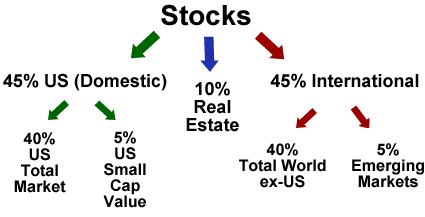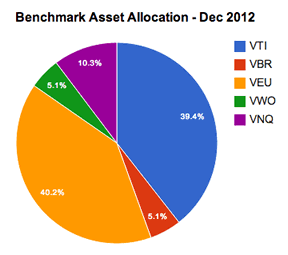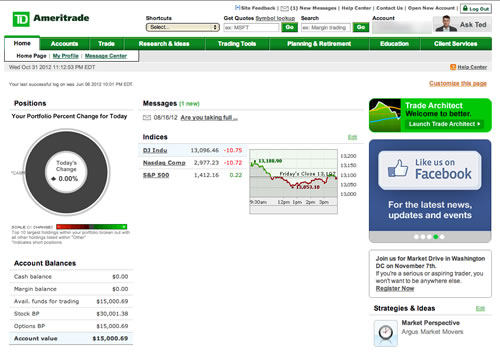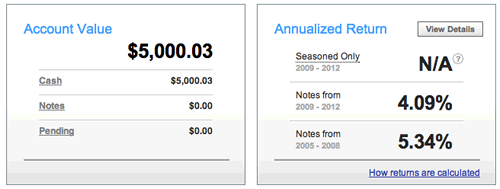As part of my Beat the Market Experiment, I started three portfolios on November 1st, 2012:
- $10,000 “Good Boy” Passive ETF Benchmark Portfolio that would serve as both a performance benchmark and an example portfolio that would be easy to build and maintain for DIY investors.
- $10,000 “Bad Boy” Beat-the-Benchmark Portfolio that would simply represent the attempts of an “average guy” who is not a financial professional and gets his news from mainstream sources to get the best overall returns possible.
- $10,000 Consumer Loan Portfolio – Split evenly between LendingClub and Prosper, this portfolio of peer-to-peer loans will have a target return of 8-10% net with the goal of beating the Benchmark portfolio over the long run.
This is the monthly update for the $10,000 Benchmark Portfolio as of December 1, 2012. I opened an account at TD Ameritrade due to their 100 commission-free ETF program, including the best low-cost, index ETFs from Vanguard and iShares. I funded it with $10,000 and bought all the ETFs required to be fully invested on 11/1/12. Due to simplicity and small portfolio size, I am going with 100% stocks and no bonds. My target asset allocation is below.

Here are the ETF components that represent each asset class:

Here are my holdings and their market value as of the end of day 11/30/12 (full screenshot):

Here’s the asset allocation:

Total value of stocks: $9,982.21
Cash balance: $24.18
Total portfolio value: $10,006.39
Not too much to talk about this month, I bought everything in a matter of minutes with no commissions at all, and a month into the experiment our total return to date is a snoozefest 0.06%. The Play Portfolio update will be up tomorrow.
 As part of my new Beat-the-Market Experiment, I have dedicated $5,000 to Prosper. As a quick recap, Prosper.com securitizes person-to-person loans so that you can lend money to other people in $25 increments and earn interest. The idea is to replace banks and credit cards as the middlemen. Since their mid-2009 re-launch after SEC registration, there have been a full cycle of 3-year Prosper “2.0” loans fully maturing with an average net return of over 8% annualized. However, this is still unsecured lending which means no car or home as collateral, and thus there is a risk of loss (which can be mitigated by diversifying in multiple loans).
As part of my new Beat-the-Market Experiment, I have dedicated $5,000 to Prosper. As a quick recap, Prosper.com securitizes person-to-person loans so that you can lend money to other people in $25 increments and earn interest. The idea is to replace banks and credit cards as the middlemen. Since their mid-2009 re-launch after SEC registration, there have been a full cycle of 3-year Prosper “2.0” loans fully maturing with an average net return of over 8% annualized. However, this is still unsecured lending which means no car or home as collateral, and thus there is a risk of loss (which can be mitigated by diversifying in multiple loans).


 Offer is back! Person-to-person loan site Prosper.com is having a another one-day promotion for borrowers who submit their loan listing on Friday, February 17th where they will actually make your entire 2nd loan payment (principal and interest) for you, up to $300.
Offer is back! Person-to-person loan site Prosper.com is having a another one-day promotion for borrowers who submit their loan listing on Friday, February 17th where they will actually make your entire 2nd loan payment (principal and interest) for you, up to $300. I kinda missed the boat last Thursday 2/17 because peer-to-peer lending site Prosper.com had a promotion going on for borrowers that stated that they would make a entire month’s loan payment for you. A quote from their e-mail:
I kinda missed the boat last Thursday 2/17 because peer-to-peer lending site Prosper.com had a promotion going on for borrowers that stated that they would make a entire month’s loan payment for you. A quote from their e-mail:




 The Best Credit Card Bonus Offers – 2025
The Best Credit Card Bonus Offers – 2025 Big List of Free Stocks from Brokerage Apps
Big List of Free Stocks from Brokerage Apps Best Interest Rates on Cash - 2025
Best Interest Rates on Cash - 2025 Free Credit Scores x 3 + Free Credit Monitoring
Free Credit Scores x 3 + Free Credit Monitoring Best No Fee 0% APR Balance Transfer Offers
Best No Fee 0% APR Balance Transfer Offers Little-Known Cellular Data Plans That Can Save Big Money
Little-Known Cellular Data Plans That Can Save Big Money How To Haggle Your Cable or Direct TV Bill
How To Haggle Your Cable or Direct TV Bill Big List of Free Consumer Data Reports (Credit, Rent, Work)
Big List of Free Consumer Data Reports (Credit, Rent, Work)